RGB空间中的彩色图像分割
⭐️
为尊重原创性!转载请注明出处:©️ Sylvan Ding’s Blog
概述
本文论述了基于欧式距离和曼哈顿距离的彩色图像分割算法,并用python实现了各个算法。之后将二者的优势结合,提出了改进后的曼哈顿距离算法:基于加权曼哈顿距离的彩色图像分割算法,在分割效果和速度上超越了传统的欧式距离分割算法。
核心思想
在一幅RGB图像中分割某个指定的颜色区域(bbox)的物体。给定一个感兴趣的有代表性色彩的彩色样点集,可得到我们希望分割的颜色的“平均”估计。平均彩色用RGB向量α\alphaα表示,分割的目的是将图像中每个RGB像素分类,即在指定的区域内是否有一种颜色。为了执行这一比较,需要有相似性度量:欧氏距离和曼哈顿距离。
欧氏距离
D(z,α)=∥z−α∥=[(z−α)T(z−α)]12=[(zR−aR)2+(zG−aG)2+(zB−aB)2]12D(z, \alpha)=\|z-\alpha\|=\left[(z-\alpha)^{\mathrm{T}}(z-\alpha)\right]^{\frac{1}{2}}=\left[\left(z_{R}-a_{R}\right)^{2}+\left(z_{G}-a_{G}\right)^{2}+\left(z_{B}-a_{B}\right)^{2}\right]^{\frac{1}{2}}D(z,α)=∥z−α∥=[(z−α)T(z−α)]21=[(zR−aR)2+(zG−aG)2+(zB−aB)2]21
其中,下标R、G、B表示向量α\alphaα和zzz的RGB分量。满足D(z,α)≤D0D(z,\alpha)\le D_0D(z,α)≤D0的点的轨道是半径为D0D_0D0的实心球体,包含在球体内部和表面上的点满足指定的色彩准则。对图像中两组点进行二值化,就产生了一幅二值分割图像。
有时会对欧氏距离进行推广,一种推广形式就是D(z,α)=[(z−α)TC−1(z−α)]1/2D(z,\alpha)=[(z-\alpha)^TC^{-1}(z-\alpha)]^{1/2}D(z,α)=[(z−α)TC−1(z−α)]1/2,其中CCC是表示我们希望分割的有代表性颜色的样本的协方差矩阵,描述了一个椭球体,其主轴面向最大数据扩展方向。当C=I3×3C=I_{3\times 3}C=I3×3时,上式退化为“球形”欧氏距离。
由于欧式距离是正的且单调的,所以可用距离的平方运算来代替,从而避免开方运算,所以我们最终的欧氏距离表达式为:
DE(z,α)=(z−α)T(z−α)D_E(z,\alpha)=(z-\alpha)^T(z-\alpha)DE(z,α)=(z−α)T(z−α)
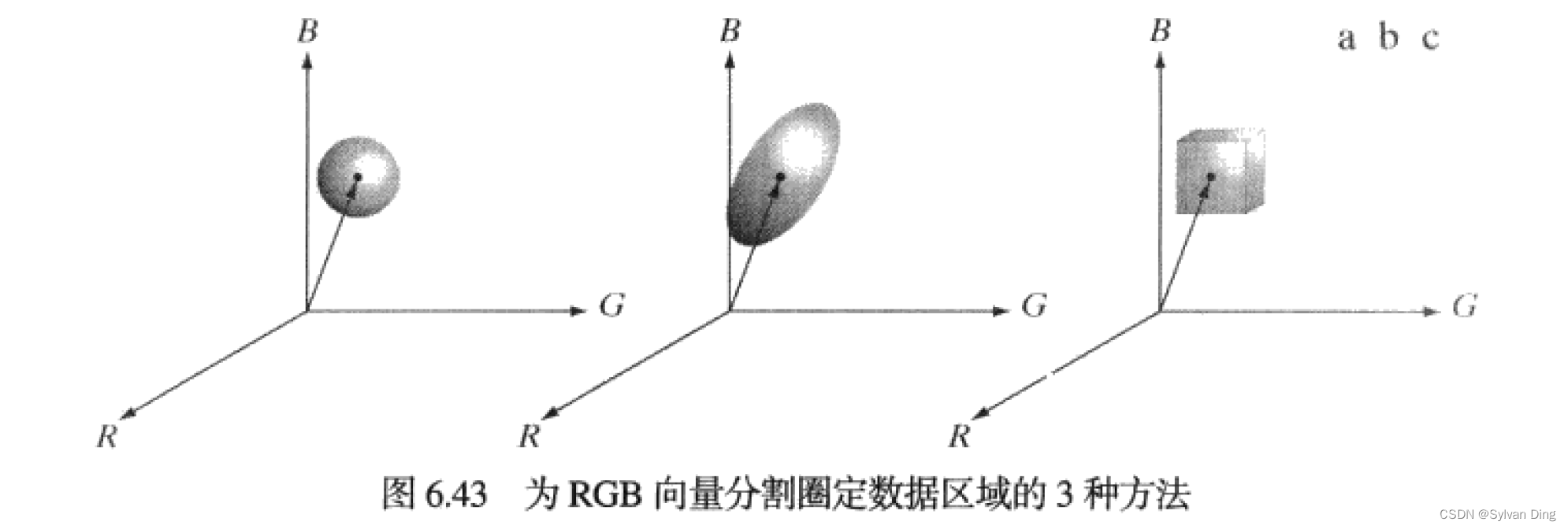
曼哈顿距离
但是,上式计算代价较高,故使用曼哈顿距离(RGB空间中的盒边界)可以大幅降低计算代价。其核心思想是在盒中心α\alphaα处,沿每一个颜色轴选择的维数与沿每个轴的样本的标准差成比例,标准差的计算只使用一次样本颜色数据。
单通道曼哈顿距离
在单通道上(以R通道为例),曼哈顿距离的定义为:
DMR(zR,αR)=∣zR−αR∣D_{MR}(z_R,\alpha_R)=|z_R-\alpha _R|DMR(zR,αR)=∣zR−αR∣
需要满足的色彩准则为:
DMR≤ησRD_{MR} \le \eta \sigma _RDMR≤ησR
其中,σR\sigma _RσR是样本点红色分量的标准差,η\etaη是标准差的系数,通常取1.251.251.25。
多通道曼哈顿距离
根据上述定义,多通道平均曼哈顿距离如下:
DM(z,α)=∣∣z−α∣∣L1=∣zR−αR∣+∣zG−αG∣+∣zB−αB∣D_{M}(z,\alpha)=||z-\alpha ||_{L1}=|z_R-\alpha _R|+|z_G-\alpha _G|+|z_B-\alpha _B|DM(z,α)=∣∣z−α∣∣L1=∣zR−αR∣+∣zG−αG∣+∣zB−αB∣
DM≤η∣∣σ∣∣L1D_{M} \le \eta \ ||\sigma ||_{L1}DM≤η ∣∣σ∣∣L1
其中,σ=(σR,σG,σB)\sigma=(\sigma _R,\sigma _G,\sigma _B)σ=(σR,σG,σB)是三通道各自的标准差向量。
多通道曼哈顿距离的改进:带权多通道曼哈顿距离
为R、G、B每个通道设定各自的η\etaη,则需要满足的色彩标准为:
DMR≤ηRσRD_{MR} \le \eta_R \sigma _RDMR≤ηRσR
DMG≤ηGσGD_{MG} \le \eta_G \sigma _GDMG≤ηGσG
DMB≤ηBσBD_{MB} \le \eta_B \sigma _BDMB≤ηBσB
实验和结果分析
import cv2
import numpy as np
import matplotlib.pyplot as pltimg = 'strawberry_color.bmp'
f_bgr = cv2.imread(img, cv2.IMREAD_COLOR)
f_rgb = cv2.cvtColor(f_bgr, cv2.COLOR_BGR2RGB)bndbox = {'xmin': 3,'ymin': 18,'xmax': 317,'ymax': 344}f_rec = cv2.rectangle(f_rgb.copy(),(bndbox['xmin'], bndbox['ymin']),(bndbox['xmax'], bndbox['ymax']),color=(255, 255, 0), thickness=5)plt.imshow(f_rec)
plt.show()
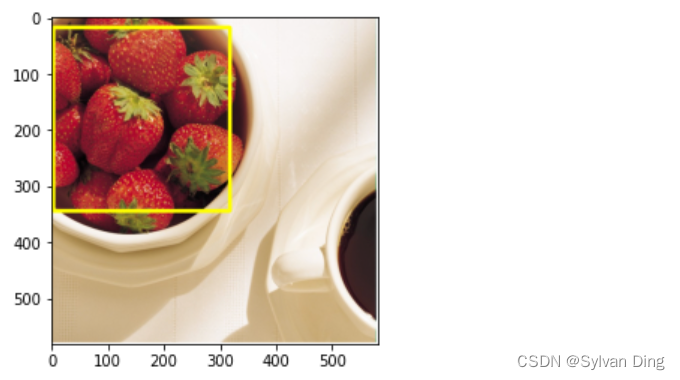
def Euclid(f, box, d0):"""Calculate Euclid distance and return binarized image:param f: img:param box: (xmin, ymin, xmax, ymax) # VOC format:param d0: condition:return: binarized image according to condition"""H, W, C = f.shapea = np.zeros(C, dtype='float')b = np.zeros((H, W), dtype='int')for c in range(C):a[c] = np.mean(f[box[0]:box[2], box[1]:box[3] ,c])a = a.reshape(C, 1)for w in range(W):for h in range(H):z = f[h, w, :].reshape(C, 1)d = z - aDE = np.dot(d.T, d)if DE.sum() <= d0:b[h, w] = 1return bdef binary_mix(f, b):"""mix input image and binarized image:param f: input image:param b: its binarized image with only two values 0 and 1:return: g"""g = f.copy()H, W, C = g.shapefor c in range(C):g[:, :, c] = np.multiply(g[:, :, c], b)return g# Euclid distanceD0_0 = 5000
g_u_b_0 = Euclid(f_rgb, list(bndbox.values()), d0=D0_0)D0_1 = 10000
g_u_b_1 = Euclid(f_rgb, list(bndbox.values()), d0=D0_1)fig, axs = plt.subplots(2, 2, figsize=(10, 10))axs[0][0].set_title('g_u_b_0: D0={}'.format(D0_0))
axs[0][0].imshow(g_u_b_0, cmap='gray')
axs[0][1].set_title('binary_mix(f_rgb, g_u_b_0): D0={}'.format(D0_0))
axs[0][1].imshow(binary_mix(f_rgb, g_u_b_0))axs[1][0].set_title('g_u_b_1: D0={}'.format(D0_1))
axs[1][0].imshow(g_u_b_1, cmap='gray')
axs[1][1].set_title('binary_mix(f_rgb, g_u_b_1): D0={}'.format(D0_1))
axs[1][1].imshow(binary_mix(f_rgb, g_u_b_1))plt.suptitle('Euclid distance')
plt.show()
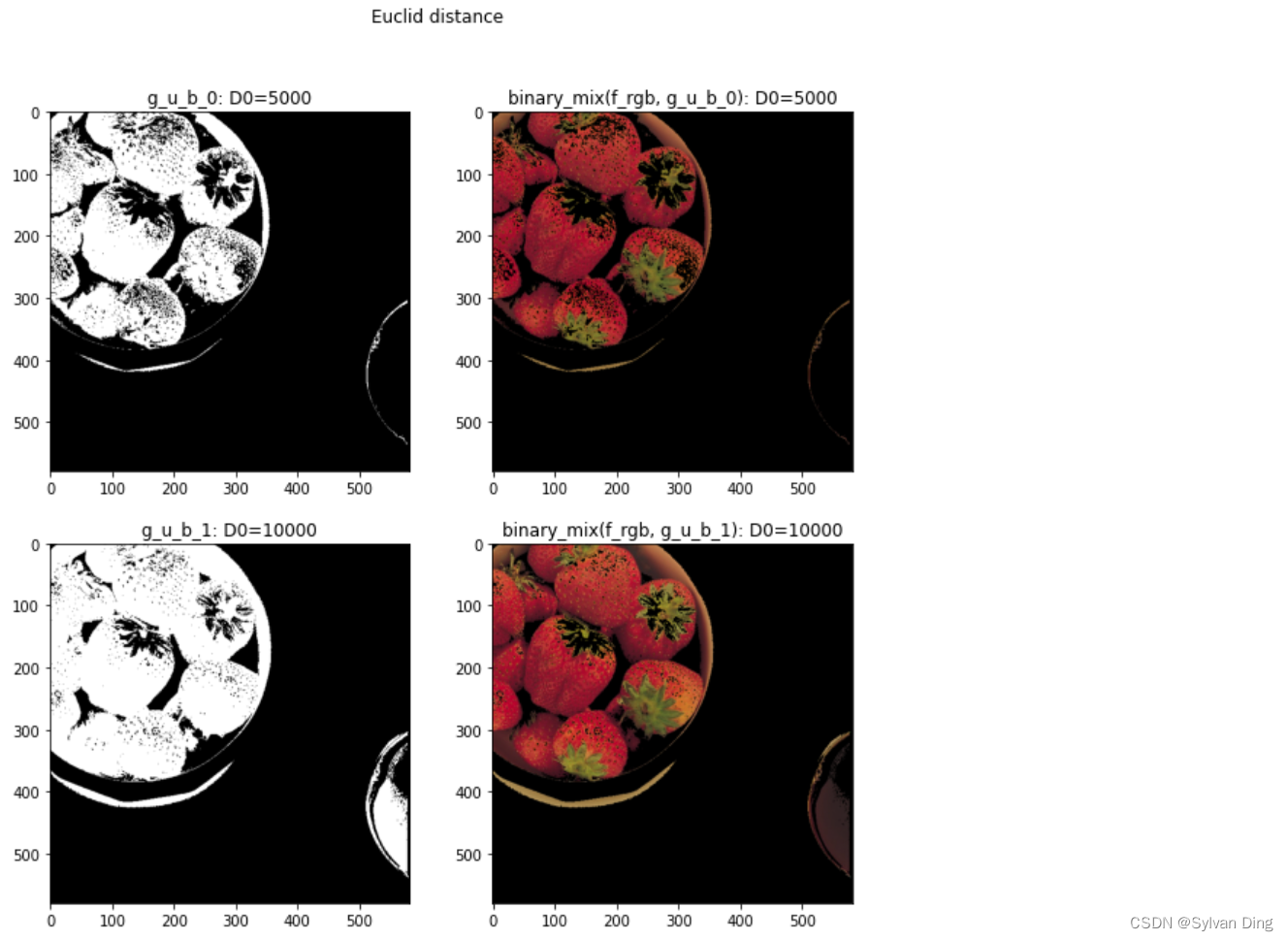
def single_Manhattan(f, box, eta, channel=0):"""Calculate single channel Manhattan distance and return binarized image:param f: img:param box: (xmin, ymin, xmax, ymax) # VOC format:param eta: condition:param channel: int, channel number:return: binarized image according to condition"""H, W, C = f.shapeb = np.zeros((H, W), dtype='int')c = f[box[0]:box[2], box[1]:box[3] , channel]a = np.mean(c)sigma = np.std(c)for w in range(W):for h in range(H):z = f[h, w, channel]if np.abs(z - a) <= eta * sigma:b[h, w] = 1return b# single red channel Manhattan distanceeta0 = 1.25
channel0 = 0g_m_b_0 = single_Manhattan(f_rgb, list(bndbox.values()), eta=eta0, channel=channel0)fig, axs = plt.subplots(2, 2, figsize=(10, 10))axs[0][0].set_title('origin')
axs[0][0].imshow(f_rgb)
axs[0][1].set_title('origin with single channel: channel={}'.format(channel0))
axs[0][1].imshow(f_rgb[:, :, channel0], cmap='Reds')axs[1][0].set_title(r'g_m_b_0: \eta={}'.format(eta0))
axs[1][0].imshow(g_m_b_0, cmap='gray')
axs[1][1].set_title(r'binary_mix(f_rgb, g_m_b_0): \eta={}'.format(eta0))
axs[1][1].imshow(binary_mix(f_rgb, g_m_b_0))plt.suptitle('single red channel Manhattan distance')
plt.show()
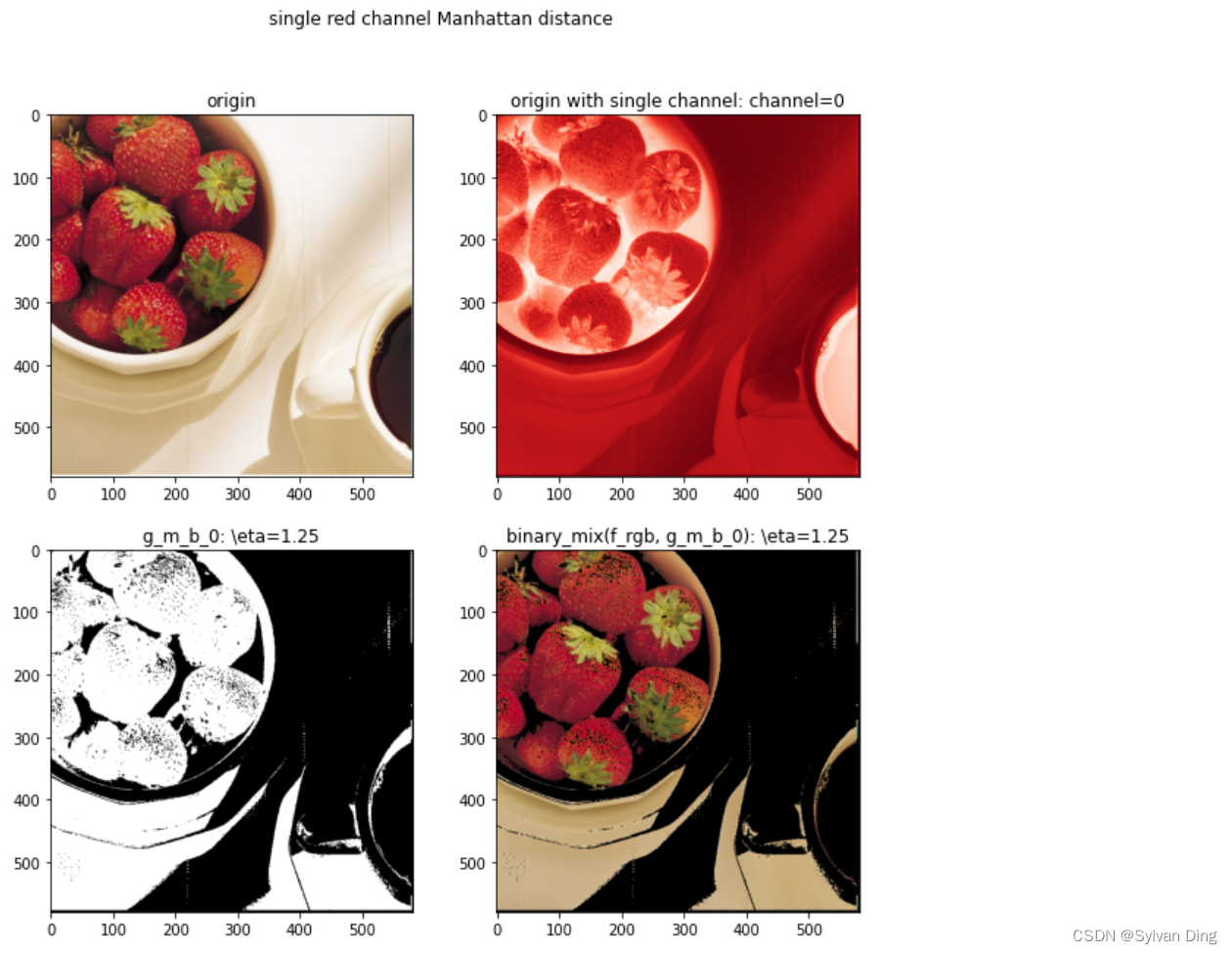
基于红色单通道的曼哈顿距离法不能很好地划分背景和草莓,这是因为在红色通道下,背景和草莓的红色值相近(图b说明了这一事实)。
# multi-channel average Manhattan distancedef multi_avg_Manhattan(f, box, eta):"""Calculate multi-channel average Manhattan distance and return binarized image:param f: img:param box: (xmin, ymin, xmax, ymax) # VOC format:param eta: condition:return: binarized image according to condition"""H, W, C = f.shapea = np.zeros(C, dtype='float')sigma = np.zeros(C, dtype='float')b = np.zeros((H, W), dtype='int')for c in range(C):sam = f[box[0]:box[2], box[1]:box[3] ,c]a[c] = np.mean(sam)sigma[c] = np.std(sam)sigmaL1 = np.sum(sigma)a = a.reshape(C, 1)for w in range(W):for h in range(H):z = f[h, w, :].reshape(C, 1)d = z - aDM = np.sum(np.abs(d))if DM <= eta * sigmaL1:b[h, w] = 1return beta1 = 1.1g_m_b_1 = multi_avg_Manhattan(f_rgb, list(bndbox.values()), eta=eta1)fig, axs = plt.subplots(1, 2, figsize=(10, 5))axs[0].set_title(r'g_m_b_1: \eta={}'.format(eta1))
axs[0].imshow(g_m_b_1, cmap='gray')
axs[1].set_title(r'binary_mix(f_rgb, g_m_b_1): \eta={}'.format(eta1))
axs[1].imshow(binary_mix(f_rgb, g_m_b_1))plt.suptitle('multi-channel average Manhattan distance')
plt.show()
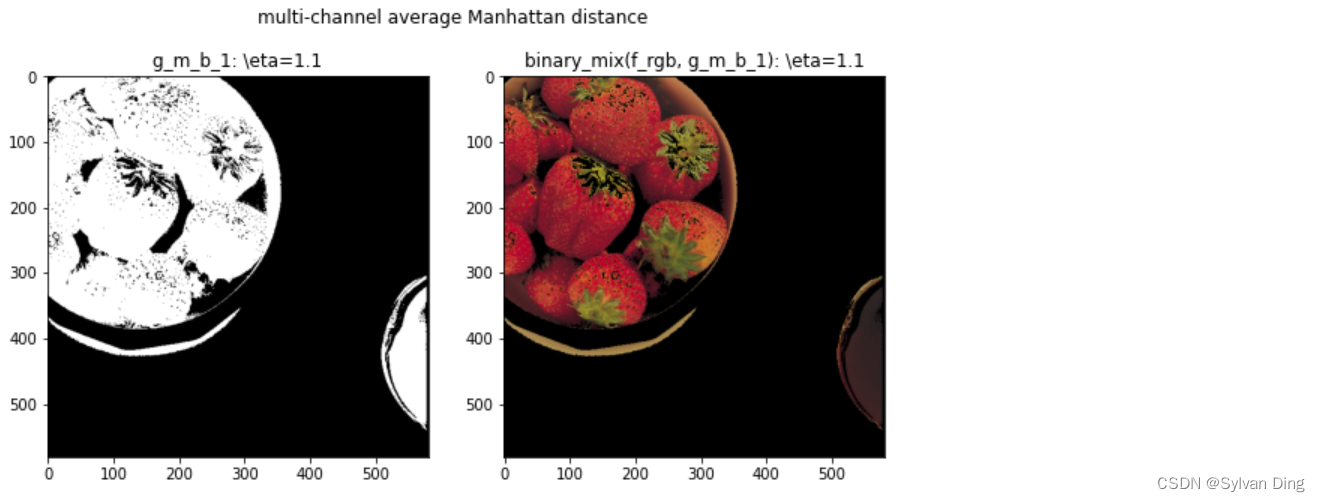
可以看到,"平均多通道"曼哈顿法优于"红色单通道"曼哈顿法。
def multi_weight_Manhattan(f, box, etas):"""Calculate multi-channel weighted Manhattan distance and return binarized image:param f: img:param box: (xmin, ymin, xmax, ymax) # VOC format:param etas: conditions for each channel like (eta0, eta1, eta2):return: binarized image according to condition"""H, W, C = f.shapebs = np.zeros_like(f, dtype='int') # bs is the valid binarized matrix for each channel of ffor c in range(C):bs[:, :, c] = single_Manhattan(f, box, etas[c], c)b = np.sum(bs, axis=2)for w in range(W):for h in range(H):if b[w, h] == C:temp = 1else:temp = 0b[w, h] = tempreturn b# RGBfig, axs = plt.subplots(1, 3, figsize=(10, 4))axs[0].set_title('R')
axs[0].imshow(f_rgb[:, :, 0], cmap='gray')
axs[1].set_title('G')
axs[1].imshow(f_rgb[:, :, 1], cmap='gray')
axs[2].set_title('B')
axs[2].imshow(f_rgb[:, :, 2], cmap='gray')plt.suptitle('RGB')
plt.show()
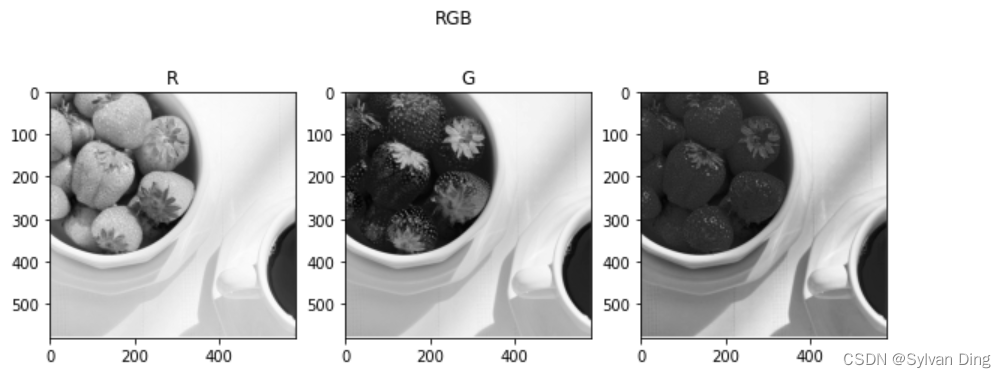
# multi-channel weighted Manhattan distanceeta2 = (1.4, 1.1, 1.3)g_m_b_2 = multi_weight_Manhattan(f_rgb, list(bndbox.values()), etas=eta2)fig, axs = plt.subplots(1, 2, figsize=(10, 5))axs[0].set_title('g_m_b_2')
axs[0].imshow(g_m_b_2, cmap='gray')
axs[1].set_title('binary_mix(f_rgb, g_m_b_2)')
axs[1].imshow(binary_mix(f_rgb, g_m_b_2))plt.suptitle(r'multi-channel weighted Manhattan distance: \etas={}'.format(str(eta2)))
plt.show()
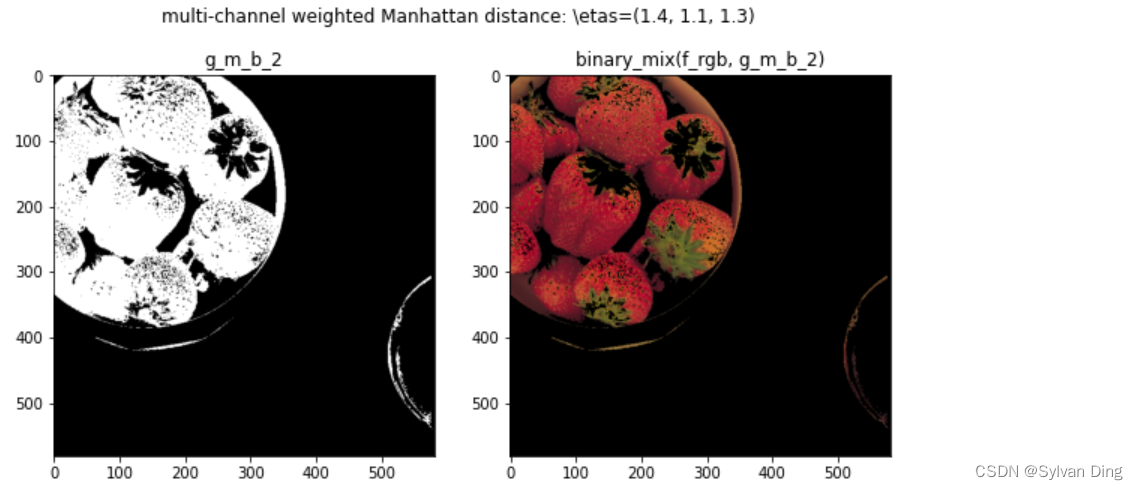
使用多通道加权曼哈顿距离法,极大提升了计算的效率,并且获得了近似、甚至优于欧几里得距离法的结果!
参考文献
- 数字图像处理:第3版,北京:电子工业出版社








)
)
![银行家算法之Python实现[操作系统实验]](http://pic.xiahunao.cn/银行家算法之Python实现[操作系统实验])

,putchar()用法)
![[操作系统]页面置换算法实验及C++实现(OPT、FIFO、LRU)](http://pic.xiahunao.cn/[操作系统]页面置换算法实验及C++实现(OPT、FIFO、LRU))



![2020-2021学年(2)操作系统考试重点[华侨大学]](http://pic.xiahunao.cn/2020-2021学年(2)操作系统考试重点[华侨大学])

